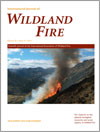International Journal of Wildland Fire
Volume 22
Number 4 2013
A review of the literature suggests at best a minor effect of live foliar moisture on the spread rate of crowning fires in conifer forests and shrublands. None of the present model functions used to adjust the spread rate for the relative effect of live foliar moisture are considered satisfactory, including application to dead foliage.
A cellular automata model integrating surface fire spread, firebrand lift-off and dispersal, as well as spot fire ignition and propagation was constructed to investigate spot fire behaviour. This study uses the model to examine how spotting under various environmental conditions may affect (i) fuelbreak jumping and (ii) the main fire’s rate of spread.
Through small-scale burning experiments, we determined the amplifying effect of fuel loading on fire behaviour and thermocouple probe temperatures at the surface of fuelbeds dominated by masticated saw palmetto and gallberry shrubs. Soil temperatures were also influenced by fuelbed properties; however, temperatures never reached 60°C as shallow as 2 cm beneath the masticated fuels.
Fire behaviour at two sites was moderately enhanced by the desiccation of tamarisk (Tamarix spp.), a flammable invasive tree, in one case from herbivory by the tamarisk leaf beetle (Diorhabda carinulata Desbrocher), and another in which herbivory was simulated with herbicide. Physical characteristics and season had a greater influence on fire behaviour than did foliar desiccation at both sites.
Initial attack success models and decision guides have been developed for grassfires in agricultural regions of southern Australia using incident and response data. These can be used by fire managers to make quick assessments of the need for extra resources at early stages of a fire.
Factors influencing lightning and arson ignitions were examined within the densely populated Sydney region of south-eastern Australia. Patterns observed were consistent with those reported for forested regions in the northern hemisphere. Climate change is likely to increase ignition frequency but population growth resulting in urban expansion is likely to have a greater effect.
Based on remote sensing data for the period 1990–2008, median fire intervals in tropical savannas in western Arnhem Land, Australia, ranged from 1 to 3 years. Closed forests experienced repeated fires within 4 years. Hazard functions were non-monotonic with peak values at 2 to 3 years. A discrete lognormal model is more appropriate than a Weibull model for fire frequency analysis in these tropical savannas.
This study reports the relationships between forest fire activity and meteorological parameters in the eastern Euro-Mediterranean region through the analysis of long-term meteorological and fire data spanning more than a century. Outputs underline the effect of precipitation in fire spread by controlling both fuel production and fuel moisture.
In Mediterranean gorse shrublands, total woody fuel diminished with repeated fires. In addition, there was no positive selection for elevated dead fuel since a second fire encouraged a community with less dead fuel. In contrast, herbaceous species were enhanced by repeated fires.
The study addresses long-term effects of single and recurrent fires on soil water repellency and organic matter content. Results indicate a significant prolonged decrease in water repellency following recurrent fires, depending on organic matter content. Soil organic matter can serve as an indicator for soil rehabilitation following recurrent fires.
Peavine Métis settlement, an Aboriginal community in Northern Alberta Canada, has a settlement-led wildfire mitigation program that includes both residential and community level activities. Local residents supported this program and engaged in additional residential mitigation activities. Residents’ wildfire experiences were found to encourage support for community level activities.
Using current cost data for the Sierra Nevada area of California, this paper adds to mounting evidence that increases in housing lead to increases in fire suppression costs.
We analysed spatial patterns of wildfire exposure in relation to key social and economic features on Sardinia. Historical data and wildfire simulations were used to estimate burn probabilities, flame length and fire size. Outputs were summarised for the features of interest, and related to spatial variation in fuels, ignitions, topography and weather.




